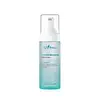What's inside
What's inside
 Key Ingredients
Key Ingredients

 Benefits
Benefits

 Concerns
Concerns

No concerns
 Ingredients Side-by-side
Ingredients Side-by-side

Water
Skin ConditioningGlycerin
HumectantMyristic Acid
CleansingPalmitic Acid
EmollientLauric Acid
CleansingStearic Acid
CleansingPotassium Hydroxide
BufferingSorbitan Olivate
EmulsifyingGlyceryl Stearate
Emollient1,2-Hexanediol
Skin ConditioningPanthenol
Skin ConditioningVincetoxicum Atratum Extract
Skin ConditioningCeramide NP
Skin ConditioningMagnesium Ascorbyl Phosphate
AntioxidantArginine
MaskingAlanine
MaskingTyrosine
MaskingHistidine
HumectantLeucine
Skin ConditioningMethionine
Skin ConditioningBetaine
HumectantTrehalose
HumectantAllantoin
Skin ConditioningSodium Methyl Cocoyl Taurate
CleansingLauramidopropyl Betaine
CleansingSodium Chloride
MaskingPolyquaternium-10
Caprylyl Glycol
EmollientEthylhexylglycerin
Skin ConditioningWater, Glycerin, Myristic Acid, Palmitic Acid, Lauric Acid, Stearic Acid, Potassium Hydroxide, Sorbitan Olivate, Glyceryl Stearate, 1,2-Hexanediol, Panthenol, Vincetoxicum Atratum Extract, Ceramide NP, Magnesium Ascorbyl Phosphate, Arginine, Alanine, Tyrosine, Histidine, Leucine, Methionine, Betaine, Trehalose, Allantoin, Sodium Methyl Cocoyl Taurate, Lauramidopropyl Betaine, Sodium Chloride, Polyquaternium-10, Caprylyl Glycol, Ethylhexylglycerin
Sodium Bicarbonate
AbrasiveSodium Lauroyl Glutamate
Zea Mays Starch
AbsorbentSodium Cocoyl Isethionate
CleansingCoconut Acid
CleansingCamellia Sinensis Leaf Powder
ExfoliatingWater
Skin ConditioningSodium Isethionate
CleansingPapain
Skin ConditioningZinc Oxide
Cosmetic ColorantLysine Hcl
Skin ConditioningSodium Ascorbyl Phosphate
AntioxidantAcetyl Methionine
Skin ConditioningTheanine
EmollientProline
Skin ConditioningBetaine
HumectantCellulose Gum
Emulsion StabilisingCitric Acid
BufferingCarica Papaya Fruit Extract
Skin ConditioningSorbitol
HumectantGlycerin
HumectantButylene Glycol
Humectant1,2-Hexanediol
Skin ConditioningSodium Hyaluronate
HumectantSodium Bicarbonate, Sodium Lauroyl Glutamate, Zea Mays Starch, Sodium Cocoyl Isethionate, Coconut Acid, Camellia Sinensis Leaf Powder, Water, Sodium Isethionate, Papain, Zinc Oxide, Lysine Hcl, Sodium Ascorbyl Phosphate, Acetyl Methionine, Theanine, Proline, Betaine, Cellulose Gum, Citric Acid, Carica Papaya Fruit Extract, Sorbitol, Glycerin, Butylene Glycol, 1,2-Hexanediol, Sodium Hyaluronate
 Reviews
Reviews

Ingredients Explained
These ingredients are found in both products.
Ingredients higher up in an ingredient list are typically present in a larger amount.
1,2-Hexanediol is a synthetic liquid and another multi-functional powerhouse.
It is a:
- Humectant, drawing moisture into the skin
- Emollient, helping to soften skin
- Solvent, dispersing and stabilizing formulas
- Preservative booster, enhancing the antimicrobial activity of other preservatives
Betaine is a common humectant (a substance that promotes retention of moisture). It's known to be gentle on the skin and can help balance hydration.
This ingredient is best for improving hydration and soothing irritated skin. Studies also show it helps even out skin tone.
Fun fact: Betaine is naturally created in the skin and body. The kind found within cosmetic products can be either plant-derived or synthetic.
Another name for betaine is trimethylglycine.
Learn more about BetaineGlycerin is already naturally found in your skin. It helps moisturize and protect your skin.
A study from 2016 found glycerin to be more effective as a humectant than AHAs and hyaluronic acid.
As a humectant, it helps the skin stay hydrated by pulling moisture to your skin. The low molecular weight of glycerin allows it to pull moisture into the deeper layers of your skin.
Hydrated skin improves your skin barrier; Your skin barrier helps protect against irritants and bacteria.
Glycerin has also been found to have antimicrobial and antiviral properties. Due to these properties, glycerin is often used in wound and burn treatments.
In cosmetics, glycerin is usually derived from plants such as soybean or palm. However, it can also be sourced from animals, such as tallow or animal fat.
This ingredient is organic, colorless, odorless, and non-toxic.
Glycerin is the name for this ingredient in American English. British English uses Glycerol/Glycerine.
Learn more about GlycerinWater. It's the most common cosmetic ingredient of all. You'll usually see it at the top of ingredient lists, meaning that it makes up the largest part of the product.
So why is it so popular? Water most often acts as a solvent - this means that it helps dissolve other ingredients into the formulation.
You'll also recognize water as that liquid we all need to stay alive. If you see this, drink a glass of water. Stay hydrated!
Learn more about Water